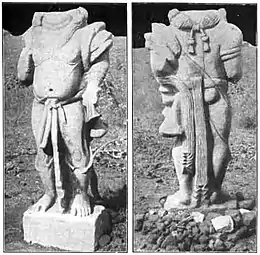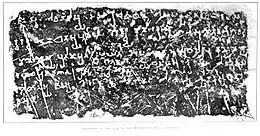Manibhadra
Manibhadra is one of the major yakshas. He was a popular deity in ancient India.
| Manibhadra | |
|---|---|
God of Property | |
 The "Parkam Yaksha" Manibhadra. | |
| Affiliation | Manigriva, Kuberaputra, Yakshyuvraj, Yakshupati |
| Abode | Alkapuri |
| Mantra | Om Yashpati Kubera putra Manibhadra Namaha |
| Weapon | Spear |
| Symbol | power |
| Mount | Mongoose |
| Personal information | |
| Parents | |
| Siblings | Nalakuvara |
| Consort | Gandhravkumari |
Iconography
Several well known images of yaksha Manibhadra have been found.[1] The two oldest known image are:
Yaksha Manibhadra from Parkham
Yaksha Manibhadra coming from Parkham near Mathura, datable to period 200 BCE – 50 BC[2] The statue is 2.59 meters high. On stylistic grounds and paleographical analysis of the inscription, the statue is datable to the middle of the 2nd century BCE.[3] The inscription says "Made by Gomitaka, a pupil of Kunika. Set up by eight brothers, members of the Manibhadra congregation ("puga")." This inscription thus indicates that the statue represents the Yaksa Manibhadra.[4] According to John Boardman, the hem of the dress is derived from Greek art. Describing a similar statue, John Boardman writes: "It has no local antecedents and looks most like a Greek Late Archaic mannerism". Similar folds can be seen in the Bharhut Yavana.[5]
 Parkham Yaksha inscription, paleographically dated to mid-2nd century BCE.[6]
Parkham Yaksha inscription, paleographically dated to mid-2nd century BCE.[6].jpg.webp) Parkham Yaksha (rear view)
Parkham Yaksha (rear view)
Yaksha Manibhadra from Padmavati Pawaya


- Yaksha Manibhadra from Padmavati Pawaya. The inscription under the image mentions a group of Manibhadra worshippers.
Both of them are monumental larger than life sculptures, often dated to Maurya or Shunga period. The Parkham Yaksha was used an inspiration by Ram Kinker Baij to carve the Yaksha image that now stands in front of the Reserve Bank of India in Delhi.[9]
Manibhadra was often shown with a bag of money in his hand.
Hinduism
Manibhadra was a son of Kubera and his wife, Bhadra. He had a brother named Nalakuvara. In Ramayana, Manibhadra fought with Ravana to defend Lanka but failed.[10] In the Mahabharata Manibhadra is mentioned along with Kubera as a chief of the yakshas. Arjuna had worshipped him.[11] The Bhagvatam narrates a story about the brothers. Once Manibhadra and Nalakuvara were playing with their respective wife or apsaras in the river Ganges. They were drunk and nude. When god sage, Narada passed by to visit Vishnu, the women covered themselves but the nude brothers were too intoxicated to see the sage and started to boast about themselves. Narada wanted to teach the brothers a lesson and cursed them to be turned into trees and only to be liberated by Vishnu avatar. During Dwapada Yuga, an infant Krishna was tied to a mortar by his mother, Yashoda as a punishment for eating dirt.[12] Krishna crawled with the mortar, however the mortar was stucked between two trees. Krishna using his divine powers uprooted the trees, liberating Nalakuvara and Manigriva from their curse.
Other legends
Another figure with the same name is mentioned to be an avatar of Shiva which he called when he was angry and summoned for warfare. Manibhadra decimated the army of Jalandhara along with Virabhadra, another avatar of Shiva.[13] It is possible that the avatar of Shiva and the chief of the yakshas may be the same Manibhadra but there is no confirmation.
Buddhism
In Samyukta Nikaya, Manibhadra is said to reside in the Manimala chaitya in Magadha. Yaksha Manibhadra is invoked in The Exalted Manibhadra’s Dhārani.[14]
Jainism


In Sūryaprajñapti, a Manibhadra chairya in Mithila is mentioned. Yakshas are referred to in the Harivamsa Purana (783 A.D.) of Jinasena made the beginning of this concept.[15] Among them, Manibhadra and Purnabadra yakshas and Bahuputrika yakshini have been the most popular. Manibhadra and Purnabadra yakshas are mentioned a chief of yakshas, Manibhadra of Northern ones and Purnabadra of Southern ones.
Manibhadra still a yaksha worshipped by the Jains, specially those affiliated with the Tapa Gachchha. Three temples are famous for association with Mandibhadra: Ujjain, Aglod (Mehsana) and Magarwada (Banaskantha). Manibhadra Yaksha (or Vira) is a popular demigod among the Jains in Gujarat.[16] His image can take many forms, including unshaped rocks, however in the most common representation, he is shown with a multi-tusked elephant Airavata.[17][18]
References
- Yaksha cult and iconography, Ram Nath Misra, Munshiram Manoharlal, 1981
- Costumes & Ornaments As Depicted in the Early Sculpture of Gwalior Museum By Sulochana Ayyar, Mittal Publications, Dec 1, 1987, p. 29
- Luders, Heinrich (1961). Mathura Inscriptions. p. 179.
- "A History of Ancient and Early Medieval India: From the Stone Age to the 12 the century" by Upinder Singh p.365
- Bharut Yavana (John Boardman, "The Diffusion of Classical Art in Antiquity", Princeton University Press, 1993, p.112.)
- Luders, Heinrich (1961). Mathura Inscriptions. p. 179.
- Boardman, John (1993). The Diffusion of Classical Art in Antiquity. Princeton University Press. p. 112. ISBN 0691036802.
- Dated 150 BCE in Fig. 15-17, general comments p.26-27 in Quintanilla, Sonya Rhie (2007). History of Early Stone Sculpture at Mathura: Ca. 150 BCE - 100 CE. BRILL. ISBN 9789004155374.
- Of Art, Central Banks, and Philistines, RBI History Project, http://www.rbi.org.in/History/Mis_Ane_OfArtCentralBankers.html
- Ramayana: King Rama's Way, William Buck, Barend A. Van Nooten, Shirley Triest, University of California Press, Nov 1, 2000, p. 32–33
- Hinduism: An Alphabetical Guide, Roshen Dalal, Penguin Books India, Oct 5, 2011, p. 240
- Prabhupada, His Divine Grace A. C. Bhaktivedanta Swami; Prabhupada, Disciples of His Divine Grace A. C. Bhaktivedanta Swami (31 December 1977). Srimad-Bhagavatam, Tenth Canto: The Summum Bonum. The Bhaktivedanta Book Trust. ISBN 978-91-7149-643-0.
- http://www.sacred-texts.com/hin/hmvp/hmvp43.htm
- THE DHĀRANI OF THE EXALTED MANIBHADRA Archived 2 July 2012 at the Wayback Machine, Translated from Tibetan by Erick Tsiknopoulos
- "Symbols, Ceremonies and Practices" by Pramodaben Chitrabhanu
- Yakshraj Shree Manibhadradev, Nandlal B Devluk, Arihant Prakashan, 1997
- Kristi L. Wiley (17 June 2009). The A to Z of Jainism. Scarecrow Press. p. 138. ISBN 978-0-8108-6337-8.
- Shah, U. P. (September–December 1982). "Minor Jaina deities". Journal of the Oriental Institute. Baroda: Oriental Institute, Maharaja Sayajirao University of Baroda. XXXII (1–2): 97–98.
- Sources
- Mathew, Ammu (2008). ManoramaTell me why No.32. Monorama Press. ISBN 0-9750-4300-5.
- Hopkins, Edward Washburn (1915). Epic mythology. Strassburg K.J. Trübner. ISBN 0-8426-0560-6.
- Sutherland, Gail Hinich (1991). The disguises of the demon: the development of the Yakṣa in Hinduism and Buddhism. SUNY Press. ISBN 0-7914-0622-9.

